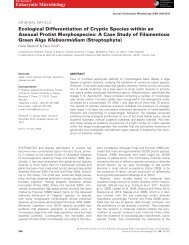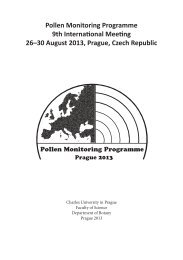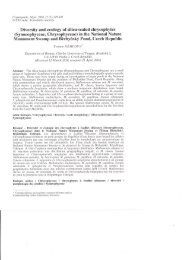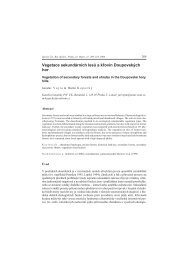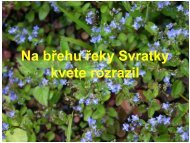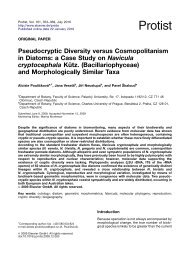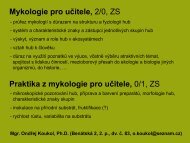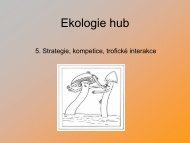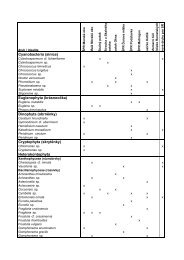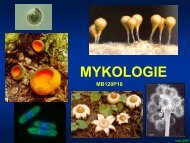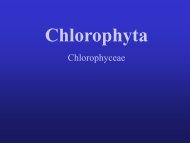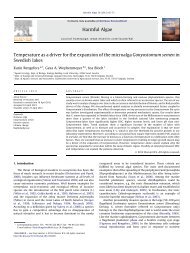Trebouxiophyceae, Chlorophyta - (S)FTP hesla na Botany
Trebouxiophyceae, Chlorophyta - (S)FTP hesla na Botany
Trebouxiophyceae, Chlorophyta - (S)FTP hesla na Botany
Create successful ePaper yourself
Turn your PDF publications into a flip-book with our unique Google optimized e-Paper software.
General introduction<br />
More variable markers, such as the gene introns, provide high resolution in phylogenetic<br />
studies and they are useful in identifying and delimiting cryptic and phylogenetic species<br />
and for use in population genetic studies. One such variable marker, the actin type I intron,<br />
was reported by Liss et al. (1997), who observed high levels of its variation in Chlamydomo<strong>na</strong>s<br />
and Volvox (Fig. 10). Afterwards, actin introns were used to investigate the cryptic<br />
diversity in lichen photobionts Trebouxia s. str. (Kroken & Taylor 2000) and Asterochloris<br />
(Nelsen & Gargas 2006, 2008).<br />
Fig. 10. Diagram illustrating the organisation of the actin genes of Chlamydomo<strong>na</strong>s reinhardtii with respect to exons<br />
(shaded boxes) and introns (open boxes) (After Liss et al. 1997).<br />
1.4 Species concepts<br />
All the above-mentioned morphological and molecular markers are frequently applied<br />
for description and delimitation of particular species of coccal green algae. However, given<br />
two organisms, how can we distinguish, whether they belong to the same species or not? The<br />
answer may be straightforward for two divergent organisms, but it can be extremely difficult<br />
and laborious in closely related ones. That is why many different concepts of species have<br />
been and are held by biologists.<br />
According to the morphological<br />
species concept, species are the<br />
smallest groups that can be repeatedly<br />
defined by structural characteristics<br />
that are relatively easy to distinguish<br />
(Fig. 11). However, some morphological<br />
species have been observed to<br />
undergo seaso<strong>na</strong>l succession or distinct<br />
morphological variability depending<br />
on environmental conditions<br />
(Luo et al. 2006; Stoyneva et al. 2007;<br />
van Holthoon et al. 2003; Verschoor<br />
et al. 2004). Therefore, frequently<br />
observed intraspecific morphological<br />
variation avoids the descriptions of<br />
species based solely on the morpho-<br />
logical differences. Moreover, traditio<strong>na</strong>l morphological species concept alone is not sufficient<br />
for species descriptions, since it does not recognize cryptic or sibling species (Behnke et<br />
al. 2004). However, due to its long tradition, previously published morphological investigations<br />
represent valuable information sources about morphological variability, uniqueness and<br />
distribution of particular green algal species.<br />
Fig. 11. Morphological species concept. Distinguishing Chlamydomo<strong>na</strong>s<br />
species according to the chloroplast morphology (after Ettl<br />
1983).<br />
The biological species concept, the most widely accepted concept among the biologists,<br />
defines species in terms of interbreeding. According to this concept, species are groups<br />
of interbreeding <strong>na</strong>tural populations that are reproductively isolated from other such groups<br />
(Mayr 1948). This is generally useful formulation for scientists working with living examples<br />
of the higher taxa like mammals, fish, and birds, but meaningless for organisms that do not<br />
reproduce sexually. In the majority of green microalgal genera, sexual reproduction has never<br />
been observed (Ettl & Gärtner 1995) and thus wide application of the biological concept is<br />
hard to imagine. However, indirect evidences on the interbreeding processes within the bio-<br />
6



